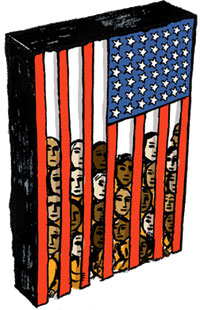
It was the summer of 1945, and World War II had ended. Former soldiers, including famous baseball stars, streamed back into America and into American life. Yankee slugger Joe DiMaggio was trying to be Yankee fan Joe DiMaggio, sneaking into a mezzanine seat with his 4-year-old son, Joe Jr., before rejoining his team. A fan noticed him, then another. Soon throughout the stadium people were chanting “Joe, Joe, Joe DiMaggio!” DiMaggio, moved, gazed down to see if his son had noticed the tribute. He had. “See, Daddy,” said the little DiMaggio, “everybody knows me!”
We all interpret the events around us according to our own worldview. By adulthood we’ve either gotten beyond the me-me-me context of 4-year-olds, or gone into politics. But drawing conclusions about data we encounter in sports, business, medicine and even our personal lives, we often make errors as significant as that of Joe Jr.
This holiday weekend—the Fourth of July—kicks off the home stretch of a two-month period that made Joe DiMaggio Sr. an icon of American culture. In 1941, a few months before Joe Jr. was born, and sandwiched between the day Hitler’s insane deputy Rudolf Hess parachuted into Scotland on an unauthorized peace mission and the day a secret British report concluded that the Allies could complete an atomic bomb ahead of Germany, there was a period of 56 successive Yankee games in which Joltin’ Joe had at least one hit.
DiMaggio’s hitting streak was an inspiration in troubled times. The pursuit of any record comes with pressure—Roger Maris lost some of his hair during his attempt to break Babe Ruth’s home-run record in 1961—but most records forgive you an off day as long as you compensate at other times. Not so with a streak, which demands unwavering performance. And so DiMaggio’s streak has been interpreted as a feat of mythic proportion, seen as a heroic, even miraculous, spurt of unrivaled effort and concentration.
But was it? Or was this epic moment simply a fluke?
Recent academic studies have questioned whether DiMaggio’s streak is unambiguous evidence of a spurt of ability that exceeded his everyday talent, rather than an anomaly to be expected from some highly talented player, in some year, by chance, something like the occasional 150-yard drive in golf that culminates in a hole in one. No one is saying that talent doesn’t matter. They are just asking whether a similar streak would have happened sometime in the history of baseball even if each player hit with the unheroic and unmiraculous—but steady—ability of an emotionless robot.
That randomness naturally leads to streaks contradicts people’s intuition. If we were to picture randomness, we might think of a graph that looks jerky, not smooth like a straight line. But random processes do display periods of order. In a toss of 100 coins, for example, the chances are more than 75% that you will see a streak of six or more heads or tails, and almost 10% that you’ll produce a streak of 10 or more. As a result a streak can look quite impressive even if it is due to nothing more than chance.
A few years ago Bill Miller of the Legg Mason Value Trust Fund was the most celebrated fund manager on Wall Street because his fund outperformed the broad market for 15 years straight. It was a feat compared regularly to DiMaggio’s, but if all the comparable fund managers over the past 40 years had been doing nothing but flipping coins, the chances are 75% that one of them would have matched or exceeded Mr. Miller’s streak. If Mr. Miller was really merely the goddess of Fortune’s lucky beneficiary, then one would expect that once the streak ended there would be no carryover of his apparent golden touch. In that expectation Mr. Miller did not disappoint: in recent years his fund has significantly lagged the market as he bet on duds like AIG, Bear Stearns, Merrill Lynch & Co. and Freddie Mac.
Of course a 10- or 15-game streak is a far cry from one of 56 games. This is where DiMaggio’s great ability plays a role, for if we are to compare DiMaggio’s performance to a coin, it must be a weighted coin. With a lifetime batting average of .325, DiMaggio had a better-than-75% chance of getting a hit in a game, while a balanced coin has but a 50% chance of success. Moreover, each year for over a century, hundreds of players have sought to achieve a streak such as DiMaggio’s. All those factors increase the odds that such a streak could have occurred by chance alone.
It’s not just the statisticians who wonder whether our heroes achieve records more often than coins. Psychologists, and, increasingly, economists, also puzzle over the seemingly discrete worlds of chance and perception. The fusion of those worlds was sanctified when half of the 2002 Nobel Prize in economics was awarded to psychologist Daniel Kahneman “for having integrated insights from psychological research into economic science, especially concerning human judgment and decision-making under uncertainty.”
Research into why people misinterpret streaks dates to 1985, and a paper co-authored by Mr. Kahneman’s regular collaborator, the late Amos Tversky, in the journal Cognitive Psychology. (No one doubts that, had he lived, Mr. Tversky would have shared in the prize). The paper was titled “The hot hand in basketball: On the misperception of random sequences.” Everyone who has ever played basketball knows the feeling of being “in the zone.” Your hand is on fire. You can’t miss. But are you feeling a true increase in ability, or is your mind inferring it because you just took a bunch of shots that, for whatever reason, went in?
If a person tossing a coin weighted to land on heads 80% of the time produces a streak of 10 heads in a row, few people would see that as a sign of increased skill. Yet when an 80% free throw shooter in the NBA has that level of success people have a hard time accepting that it isn’t. The Cognitive Psychology paper, and the many that followed, showed that despite appearances, the “hot hand” is a mirage. Such hot and cold streaks are identical to those you would obtain from a properly weighted coin.
Why do people have a hard time accepting the slings and arrows of outrageous fortune? One reason is that we expect the outcomes of a process to reflect the underlying qualities of the process itself. For example, if an initiative has a 60% chance of success, we expect that six out of every 10 times such an initiative is undertaken, it will succeed. That, however, is false. In order to warrant confidence that results reflect a deeper truth, you need many more trials than 10. In fact, one of the most counterintuitive features of randomness is that for a small number of trials, the results of a random process typically do not reflect the underlying probabilities.
For example, suppose we undertake an analysis of the resources, effort and ability of all the companies in the Fortune 500 and determine that every company has the same 60% chance of success in any given year. If we observe all the companies over a period of five years and the underlying probability of success were reflected in each company’s results, then over the five-year period every company would have three good years.
The mathematics of chance indeed dictate that in this situation the odds of a company having zero, one, two, four or five good years are lower than the odds of having three. Nevertheless it is not likely that a company will have three out of five good years—because there are so many of those misleading outcomes, their combined odds add up to twice the odds of having exactly three. That means that of the 500 companies, two-thirds will experience results that belie their underlying potential. In fact, according to the rules of randomness, nearly 50 of the companies will have a streak of either five good years, or five bad years, even if their corporate capacities were no better or worse than their counterparts’. And so if you judged the companies by their five-year results alone, you would probably over- or underestimate their true value.
In sports, the championship contenders are usually pretty evenly matched. But in baseball, even if one assumes that the better team has a lopsided 55/45 edge over the inferior one, the lesser team will win the seven-game World Series 40% of the time. That might seem counterintuitive, but you can look at it as follows. If you play a best-of-one game series, then, by our assumption, the lesser team will win 45% of the time. Playing a longer series will cut down that probability. The problem is that playing a seven-game series only cuts it down to 40%, which isn’t cutting it down by much. What if you demand that the lesser team win no more than 5% of the time—a constraint called statistical significance? The World Series would have to be the best of 269 games, and probably draw an audience the size of that for Olympic curling. Swap baseball for marketing, and you find a mistake often made by marketing departments: assuming that the results of small focus groups reflect a trend in the general population.
We find false meaning in the patterns of randomness for good reason: we are animals built to do just that. Suppose, for example, that you sit a subject in front of a light which flashes red twice as often as green, but otherwise without pattern. After the subject watches for a while, you offer the subject a reward for each future flash correctly predicted. What is the best strategy?
A nonhuman animal in this situation will always guess red, the more frequent color. A different strategy is to match your proportion of red and green guesses to the proportion you observed in the past, that is, two reds for every green. If the colors come in some pattern that you can figure out, this strategy will enable you to be right every time. But if the colors come without pattern you will do worse. Most humans try to guess the pattern, and in the process allow themselves to be outsmarted by a rat. (Those trying to time the market lately might wish they had let the rat take charge.) Looking for order in patterns has allowed us to understand the patterns of the universe, and hence to create modern physics and technology; but it also sometimes compels us to submit bids on eBay because we see the face of Jesus in a slice of toast.
Another reason we reject the power of randomness is our need for control. DiMaggio’s streak affects us because we all appreciate struggle and effort, triumphing despite huge odds. The notion that we might not have control over our environment, on the other hand, causes us to shudder.
Many studies illustrate how this basic aspect of human nature translates to a misperception of chance. For example, a group of Yale students were asked to predict the result of a series of coin tosses. The tosses were secretly rigged so that each student would have some success initially, but end up with a 50% success rate. The students were obviously aware of the random nature of their task. Yet when asked whether their performance would be hampered by distraction, and whether it would improve with practice, a significant number indicated that it would. Their deep-seated need for control trumped their intellectual understanding of the situation.
What about DiMaggio’s streak? There are many subtleties in randomness. For example, do you model a player as having a fixed batting average—that is, probability of a hit—or do you allow for the average to vary within the season, or even game to game? How do you treat the variation in at-bats, walks, etc.? The analyses can get long and the number of data needed unwieldy, so the jury is still out, but one of the studies, by Samuel Arbesman and Stephen H. Strogatz of Cornell University, attacked the problem by having a computer generate a mock version of each year in baseball from 1871 to 2005, based on the players’ actual statistics from that year. The scientists had the computer repeat the process 10,000 times, generating in essence 10,000 parallel histories of the sport.
The researchers found that 42% of the simulated histories had a streak of DiMaggio’s length or longer. The longest record streak was 109 games, the shortest, 39. In those 10,000 universes, many other players held the record more often than DiMaggio. Ty Cobb, for example, held it nearly 300 times.
DiMaggio’s streak, for better or worse, defined his life. Decades later, constantly hounded by autograph seekers, he wrote “If I thought this would be taking place due to the streak, I would have stopped hitting at 40 games.” He died just 10 years ago, at age 84. Joe Jr., who had trouble coping with his father’s fame, fell to a history of drug and alcohol abuse. He died five months after his father.
People are remembered—and often rewarded—not for their usual level of talent or hard work, but for their singular achievements, the ones that stand out in memory. It does no harm to view those achievements as heroic. But it does harm us to make investments or other decisions on a basis of misunderstanding. And it can be sad or even tragic when we interpret as failures plans or people simply because they did not succeed. Extraordinary events, both good and bad, can happen without extraordinary causes, and so it is best to always remember the other factor that is always present—the factor of chance.













